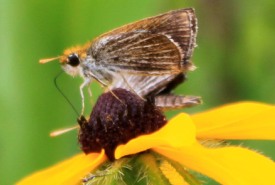A fine balance: An update on the Poweshiek skipperling

NCC’s Tall Grass Prairie Natural Area protects Canada’s only population of endangered Poweshiek skipperling. (Photo by NCC)
It may be a small and unassuming species, but for a few years now scientists in both Manitoba and the U.S. have been playing close attention to the Poweshiek skipperling. The small, brownish butterfly — about the size of a loonie — was once common throughout Manitoba and parts of the Midwest U.S. but now it’s become rarer than a panda. If things don't turn around for the species, it could be at risk of extinction in the blink of an eye.
Here in the Manitoba office of the Nature Conservancy of Canada (NCC), we’ve been paying particularly close attention because it just so happens that most of the known Canadian breeding populations of Poweshiek skipperling are found on our properties in the Tall Grass Prairie Natural Area.
What’s the latest on the state of the Poweshiek? At last count, the numbers in Canada are stable but critically low — only 44 adults were detected in 2014.
This year in partnership with the University of Winnipeg we plan to continue our field surveys for the species in both known and new locations. We’ll also continue to support our research partnership with the University of Winnipeg, whose researchers are looking into the species’ microhabitat requirements (to understand the soil type and moisture and other key environmental factors the species requires in order to successfully breed and thrive). This knowledge will impact how we conserve and manage land in the future.
A number of partners are also continuing a variety of research projects on the species, including:
- A captive breeding program being developed by the Minnesota Zoo;
- Genetics work to better understand the species itself;
A project to determine the scale, timing and type of land management activities that best contribute to the species' recovery.
We’ve also been busy analysing years of data related to Poweshiek skipperling annual counts, habitat, fire, grazing and weather. In fact, we’ve learned a lot about land management practices and weather and what the species prefers and doesn’t. Staff and partners are hard at work analyzing this information to share their findings in a scientific paper.
NCC staff also participate in regular conference calls with other practitioners and experts. Perhaps one of our biggest challenges is that until recently no one knew much about this species. But working together, we hope to share our knowledge so that we can turn the tide in the Poweshiek skipperling’s race against time.


